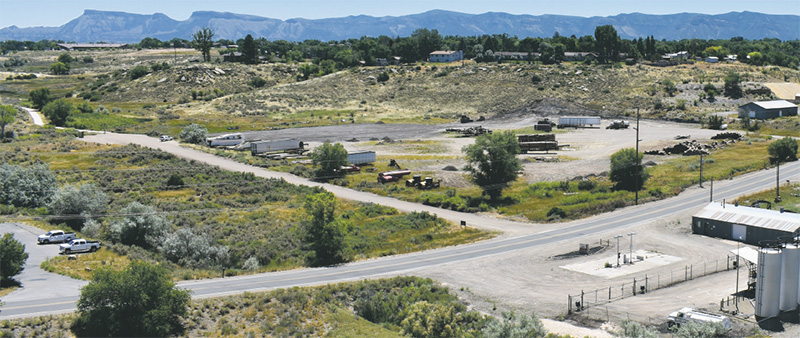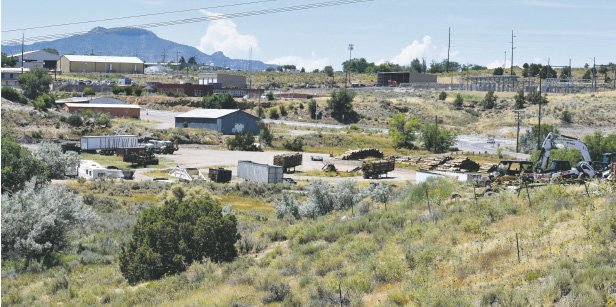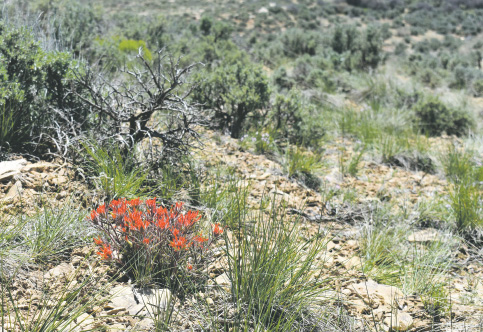
A proposed change in zoning for a 10-acre tract that sits along Lebanon Road and the road leading to the trailhead for Cortez’s Carpenter Natural Area has proven to be controversial. The tract, shown in the upper right of this photo, belongs to the Independent Log Company. Photo by Gail Binkly
In August, the Cortez City Council is poised to wrestle with a highly contentious issue: whether to place an industrial zone near the entrance to a city park.
The arguments over whether to change the zoning of a 10-acre parcel adjoining the Carpenter Natural Area from commercial to industrial have been raging for months. The parcel is owned by Anthony Moore and Mary Lancaster of Independent Log Company, who hope to use it for producing log homes, storing firefighting equipment and other related purposes.
It sits along the entrance road to the Carpenter Trail at its west end, which is on the city’s northern edge off Lebanon Road. The mile-and-a-half-long trail crosses land left mostly in its natural state, with native vegetation, a small stream and a pond that dries up in the summer. To the north, over a ridge, is the Geer Natural Area, featuring miles of cycling trails.
Note: The author has taken part in cleanups of the Carpenter Natural Area and has frequently walked the trail.
Proponents of the rezoning say the Independent Log project would align with other businesses along Highway 491 and Lebanon Road and would be valuable to the area.
“We’re trying to come into this community to help,” said Moore during a July 18 hearing before the city Planning and Zoning Commission.
Moore is a professional logger and he and Lancaster are certified wildland firefighters.

Independent Log Company is seeking industrial zoning for this parcel near Carpenter Natural Area. Photo by Gail Binkly
A report on the proposal, written by city planner Nancy Dosdall, supported the change in zoning, saying, “The Cortez Comprehensive plan includes numerous goals that support the requested rezone. . . [including] sustain a well-balanced and diverse local economy; encourage industries that employ City residents. . . ; encourage manufacturing businesses and other skilled labor businesses to enhance employment opportunities. . .”
But opponents see the proposal as completely incompatible with both the natural area and nearby homes, and question why the city would even consider it.
Empty for years
“If a change in zoning is permitted for this parcel, there is no point in having a zoning code,” said city resident Carol Taylor during the July 18 hearing before the Planning and Zoning Commission.
The hearing, which stretched on for more than three hours and featured numerous consultations with city attorney Patrick Coleman, reflected the sharp difference in community opinions. The four current members of P&Z were split 2-2 on several motions involving recommendations to the city council.
A tie means the motion fails, so P&Z was unable to pass a recommendation either for or against the project. (P&Z merely gives recommendations to the city council.)
The council is set to have a first reading of a resolution supporting the rezoning on Tuesday, Aug. 8, with the public hearing and actual vote on the issue on Aug. 22. It is also going to consider a conditional use permit for the property that would allow for additional uses there.
The couple bought the property at 1050 Lebanon Road in October 2021. They own several other tracts nearby, including one at 10206 Highway 491, on the west side of the highway. On July 25, the Cortez City Council voted 7-0 to grant approval for a change of zoning from commercial to industrial for the highway property. No one from the public came to speak against the idea.
But the zoning change for 1050 Lebanon Road faces a considerably more difficult battle.
The 10-acre tract, once the site of a drive-in theater, has been empty for decades. It sits at the base of a hill on which residential homes stand, and stretches partway up that hill. It’s also near the trailhead accessing the Carpenter Natural Area, a 180-acre space that was started when the Carpenter family gave 76 acres to the city in 1993.
Some 40 people attended the July 18 hearing before P&Z. A dozen citizens spoke against the rezoning, five in favor of it.
‘A perfect location’
According to a document submitted by the applicants, they plan to use the land to store wildland firefighting equipment and hope to also have a wildland firefighting training facility there.
In addition, they would use logs taken from the San Juan National Forest to build “Swedish Style Cope Log Homes and Timber Frame log homes,” the document says. Logs would be stored on-site and a Wood Mizer Mill would shape them. Byproduct wood would be turned into firewood using a Cord King processor.
All the sawdust produced would be stored inside a trailer, then hauled away for use in animal bedding and other things, the document says.
“All our wood comes from the local San Juan forests USDA timber sales, and we are a huge part in the removal of this dead and dying wood and keeping the forest healthy,” the document says.
“Both properties will be used for equipment storage for example water trucks, logging trailers, enclosed trailers, and other equipment we use for firefighting, logging, and log home manufacturing,” the document states. “…Firewood, slabs and rough-cut lumber will be processed and sold locally onsite and delivered. Log home furniture and railing will also be on both locations.”
City planner Dosdall explained to P&Z that under the city code, outside storage of commodities is allowed only in industrial zones, and firewood is considered a commodity, so this necessitated the change in zoning.
At various meetings, Lancaster and Moore, who were both born in Montezuma County, said they had operated their business out of Alamosa, Colo., but wanted to return here. However, they had difficulty finding land.
“Five years ago we began looking at properties all around this area,” Moore told P&Z, “but there’s none. I’d have to go out to Dove Creek to get any bare land out there.”
He reiterated that to the city council on July 25. “Montezuma County is so developed any more, there’s homes along every road, every nook and cranny,” he said.
But in the area along 491 and Lebanon, he said, they have purchased five tracts. “We feel that it’s in a perfect location.”
Spot zoning?
During the hearing, Julie Suckla, owner of a local real-estate company, told P&Z they should recommend approval of the project. She spoke about the need for housing and for wildfire mitigation.
She said people moving into the local area see the most important factors as “clean air and our mountains.”
“When our skies are filled with smoke that’s all we see, and having this resource is something we haven’t had in the past,” Suckla said.
Shak Powers of Cortez, former Montezuma County administrator, said the project would provide a boost to the economy.
He frequently runs in Carpenter and it is “completely surrounded by commercial and industrial uses already,” he said, “so I don’t imagine the proposed rezoning would have a detrimental effect.”
Dave Waters, who with his wife Lana owns D&L Construction, spoke about their construction yard on Road L adjoining the Geer and Carpenter natural areas on their north side. “Have you ever heard noise from it?” he asked.
“These people deserve the right to prove themselves. They checked the boxes. Do your job and approve it,” he told P&Z. But other citizens disagreed sharply.
Gala Pock of Pleasant View, a former member of the county’s Planning Commission, said a rezoning would be “clearly spot zoning,” which means granting a zoning designation that is at odds with the neighborhood. Spot zoning is generally viewed as an unfair way to allow people to get around regular zoning plans.
Emily Waldron of Cortez, who said she’d also served on a planning group in another city, agreed. “The presumed scarcity of industrial sites will not be solved by spot zoning,” she said. “This is very clearly an instance of spot zoning.”
Jim Skvorc of P&Z, who ultimately voted against recommending the rezoning, pointed out that much of the tract is bordered by a residential neighborhood and Carpenter’s open space, rather than industrial activity. “I think the original zoning was correct,” he said.
Teri Paul, representing a group called the Neighbors and Friends of Carpenter, said, “I agree that this business does important and valuable work in firefighting. We argue that this is not the place for that business.”
She said the group believes that the proposed uses are incompatible with the homes and natural areas.
“Planning has not adequately addressed the problems of noise, lights, time of operation, accumulation of sawdust piles, smoke, exhaust, dust, fire, accumulation of debris and discarded equipment, increased traffic of heavy equipment, impact on wildlife of the natural area, etc.,” Paul said.
John Brzovic, who said he lives about a half-mile away, voiced concern about the appearance at the trailhead. “it is no longer recognizable as a park entrance,” he said, “with the unsightly collection of trucks, heavy machinery, log piles and 55-gallon drums.”
The applicants and staff had revised the original site plan to provide for 20-foot-tall evergreen trees as screening along the road into the Carpenter area, but several people pointed out that it would take many years for trees to grow to that height.
Moving ahead
Several citizens criticized the applicants for having moved ahead with some activities on the site without obtaining permits.
The city also mentioned that in its staff report, which stated, “ The Owners/Applicants, who also own the parcel located at 1107 Lebanon Road directly west of this subject property, are already using the property for equipment and material storage for the business. They have been cited for code violations for operating without permits.”
The citation involved verbal warnings rather than any actual citation, Rachael Marchbanks, the city’s community and economic development director, explained in an email to the Four Corners Free Press.
“The staff report probably could have been more artfully worded with respect to the City’s enforcement efforts relating to Anthony Moore and Mary Lancaster, ” Marchbanks wrote. “The City’s enforcement efforts consisted of verbal warnings . . . that the owners/applicants ongoing grading activities required a grading permit, and that the various log operations are not allowed in the current zone district without additional City permits or a change in zoning.”
In response, the applicants did obtain a grading permit, and worked with planning staff to “begin the process of applying for the applicable permits and zoning changes necessary to allow them to conduct their operations in compliance with the Land Use Code,” Marchbanks said.
Another issue brought up was noise.
The mill makes 75 decibels of sound, which is comparable to a lawnmower, according to the document they submitted, while the Cord King processor emits 90 decibels.
“Once the company is in full operation with the continuous cacophony of sound coming from the sawmill, chainsaws, electric saw and trucks, I can’t imagine anyone wishing a peaceful walk to use this section of the park,” Brzovic said.
Paul Dewitt of Cortez said 85 decibels is generally considered the sound threshold where extended exposure leads to permanent hearing loss. Traffic noise is about 70 decibels, he said.
The decibel scale is a logarithmic scale, he explained, meaning an increase of 10 decibels is a 10-fold increase.
The Wood Mizer mill the applicants plan to use is rated at 89 decibels by the manufacturer, Dewitt said. “This is three times louder than that accepted threshold.” The Cord King processor is 100 times louder than traffic, he said. “The noise levels as estimated by the manufacturer are thee to four times safe levels.”
But Moore and Lancaster disputed that. “If you walk away 20 feet from 89 decibels you can hardly hear it,” Moore said. Lancaster said it would be like a lawn mower.
The applicants’ documents don’t give hours of operation, but Moore told the city council on July 25, when talking about the other piece of property on Highway 491, that hours for the production of log homes would be normal business hours. If they happen to be dispatched to a wildfire, they would need to load firefighting equipment and that could happen at odd hours, but it wouldn’t happen often, he said.
Uniqueness
Moore said they employ 30 to 50 people in processing the logs and building log homes. “We need to have something for them to do when there ain’t a fire,” he said. “This helps a lot of people.”

Indian paintbrush is one of numerous native plant species in the Carpenter Natural Area. Photo by Gail Binkly
Pock questioned the amount of jobs that would actually be available to local people. She spoke about the Ironwood mill near Dolores, noting that Ironwood at one point applied to be able to put in “mancamp trailers because they couldn’t find local workers to work in their sawmill. They were bringing people in, so if you think this is going to produce jobs for the local men it may not.”
Several people spoke to P&Z about the value of the natural area, its wildlife and plants.
April Baison, a resident of Montezuma County, said she visits Carpenter every day and spoke of its uniqueness.
“There is nothing like it in surrounding communities – Durango, Pagosa Springs, Farmington, Shiprock, Monticello, to name a few. One hundred eighty acres roughly with over 170 species of plants, with most native. That’s a lot,” she said.
“This is a great resource and something we ought to be proud of. I don’t think this particular project is compatible with a natural area.”
David Faulkner, a retired natural-resource biologist said 30 to 50 species of bird use that area at different times of the year and spoke about the wetlands area that runs through Carpenter. “The ambience of the area is something Cortez ought to be proud of and we’re going to lose that,” he said.
Former Mayor Mike Lavey praised the applicants for their ambition and said their operation appears to be a good one, but added, “I think it’s in the wrong place.”
He suggested a possible land swap where the city would take over the 10-acre parcel in exchange for giving a piece of city-owned land to them. “It’s been done in the past,” he said.
Others spoke about the fact that changing the zoning would mean the parcel would permanently be zoned industrial, and if and when Independent Log stops operating or sells the property, that could open the door for more-objectionable uses.
Katrina Weiss and Robert Rime of P&Z voted to recommend approval of the proposal to the council, while Skvorc and Lance McDaniel voted against it.
After that motion failed, Skvorc made a motion recommending denying the zoning and listed his reasons for doing so, which were that the land is adjacent on two sides to residential land and open space; the proposal isn’t compatible with adjacent uses; commercial zoning is appropriate; and the surrounding area has changed recently to residential and open space.
That motion also failed on a 2-2 vote.
‘Not backing away’
After the vote, Moore said the applicants will continue moving forward.
“For 30 years that property laid vacant from Allen’s Theater,” he said. “Everybody got spoiled watching it being vacant. . . . We’re not backing away. We’re going to move forward. So if it takes a 300-by-300 building to do this operation in a building. . .. I didn’t buy that property to leave it vacant and grow weeds and watch deer go across my property.”
He said his firefighting crew had just been dispatched to Meeker, Colo. “That’s how important my company is to this community and other communities. The fires are already starting to break out.”
He said the land is zoned commercial and he will be doing some sort of business there no matter what. “We’re all going to get real acquainted. I’m just going to apply again. . . . If this criteria doesn’t fit this I’ll put another business on it. Maybe I’ll put it back to a theater. That was all grandfather-claused in.”
He added, “I’m not paying city taxes to leave it vacant. If this doesn’t move through we’re going to go to Plan B.”
If there’s somewhere else his operation should be located, he said, “Show me on a map where you think the right area is.”








